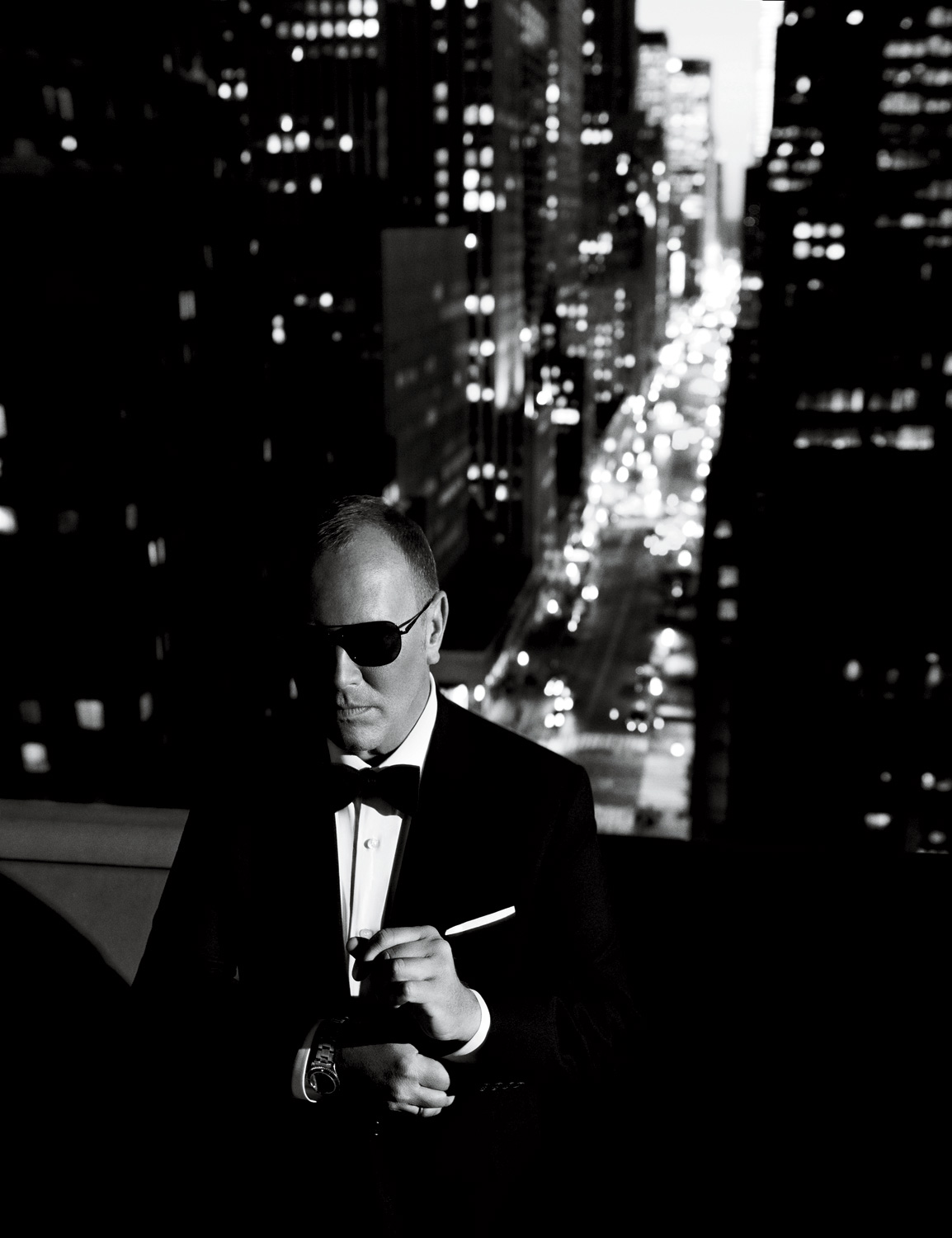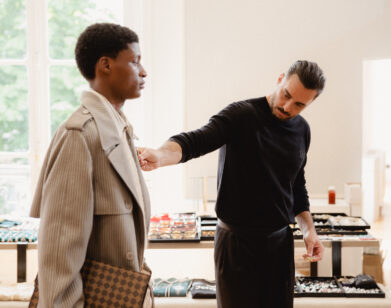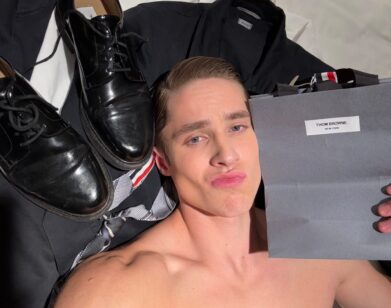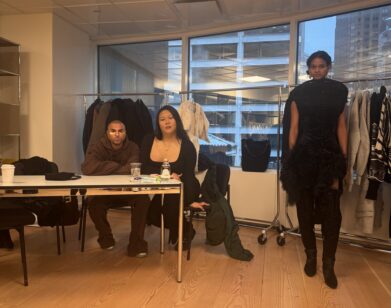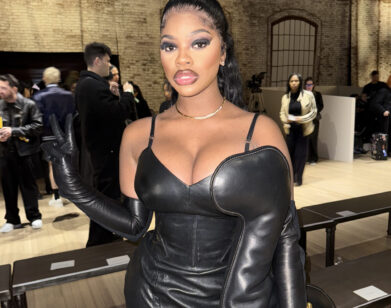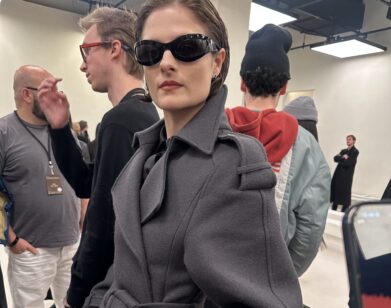Michael Kors
FASHION PEOPLE don’t LIKE to TALK ABOUT the REALITY of WHO THEY ARE. THEY REINVENT EVERYTHING. YOU KNOW, ‘My MOTHER WAS a COUNTESS … ‘WELL,MY MOTHER WASN’T a COUNTESS.’Michael Kors
It’s hard to pinpoint when Michael Kors first became a fashion designer. It might have been the moment when Dawn Mello, then-fashion director at Bergdorf Goodman, stopped by Lothar’s, the boutique on 57th Street where Kors was working as salesman/window dresser/in-house designer after dropping out of the FIT, and told him that if he ever went out on his own, she’d love to take a look at his collection. It might have been the moment in 1981 when he established his label, marking the launch of the estimated billion-dollar Michael Kors brand he runs today. But there is a good chance that it was much earlier than that.
As much of the world has come to understand from watching Kors’s work as a judge on the reality-competition show Project Runway, he loves fashion—but not in the way that your average person loves fashion. Kors’s love is an inborn love, the kind of love that’s almost preternatural. He embraces the idea of fashion in the way that someone who considers themselves a humanist might embrace the idea of humanity. He is a believer in what it stands for, in what it is, in its potential—and though he understands its fundamental limits, flaws, and fallibilities, he still wants it all to be good, both for himself and for the betterment of the greater whole.
Kors, who also did a stint as creative director of Céline from 1999 to 2003, was, of course, already well established as a designer when he began his run on Project Runway in 2004. But the platform of the show afforded him a new kind of cultural currency; suddenly, Kors was not just a successful designer, but an éminence grise of sorts known for his descriptive critiques of the creations trotted out before him. But upon closer inspection, even his greatest hits—who could forget old chestnuts like “Amish cocktail waitress,” or “transvestite flamenco dancer at a funeral,” or “She looks like a barefoot Appalachian Li’l Abner Barbie”?—have always been directed at pushing the contestants to try to be better, work harder, and aim higher. In fact, the idea that fashion might be throwaway or exist purely as a vehicle for provocation or as the product of some tortured, art-damaged process is as foreign to Kors as the idea that someone might not want to look nice or be happy. His own work bears out that ethos: His collections operate at the nexus of a kind of classically American, Jackie O-era notion of glamour and an equally American sporty pragmatism, at once supremely luxurious and eminently wearable, and in creating them, he has managed to find a sweet spot for women who, quite frankly, just want to feel good.
This year, which marks the 30th anniversary of his company, Kors is in the process of overseeing a radical phase of global expansion, with new stores opening in Hong Kong, Tokyo, London, and Toronto, to go along with the coup-de-grace: a new 7,000-square-foot flagship on Rue St.-Honoré in Paris. Earlier this summer, he also kicked off his ninth season on Project Runway. Lauren Hutton recently caught up with the 52-year-old Kors at the West Village café Sant Ambroeus in New York City, where the two enjoyed a chat over breakfast.
LAUREN HUTTON: I wanted to ask you about growing up, because as we get older we start figuring out how we found our destinies, but it’s always in hindsight.
MICHAEL KORS: We also figure out why we are who we are, why we do what we do, why it looks the way it looks.
HUTTON: So, looking back, what loves and interests do you think helped form who you are?
KORS: Well, I grew up an only child.
HUTTON: Right. Your mom was a model.
KORS: My mom was a model. She had me at 20, so she was a young mother.
HUTTON: My mom had me young, too—also when she was 20.
KORS: So I had a young mom, young grandparents. Then my mom got remarried when I was 5.
HUTTON: Me too! Five and a half . . . Trauma . . . Big trauma.
KORS: I mean, hell-o! I was 5. I was like, “What’s this about?” But I guess when my mom married my birth dad, there was no gown, no nothing. It was like, “I’m 19 years old. Let’s just get married.” But for the second go-round, my grandparents wanted her to go full-tilt with the dress and the reception and everything. So I went with my mother to a fitting and told her that I thought the dress was fussy. Too many bows going on. And my grandmother was there, too, and she thought she was a style expert.
WHEN I HEAR PEOPLE BITCH and SAY, “OH, GETTING READY FOR a SHOW . . . I’M so TORTURED!” I’M LIKE, ‘WAIT a MINUTE, THIS is WHAT WE DO IT FOR! SEEING EVERYTHING YOU’VE been DREAMING OF COME to LIFE.’Michael Kors
HUTTON: But your mother went with your instinct.
KORS: Yes, my mother listened to the 5-year-old instead of her own mother. She took all the bows off the dress, kept it clean . . .But I think what happened was not only was I an only child, but everyone in my family either had one child or no kids, so I was kind of the prodigal . . .
HUTTON: The short star surrounded by tall people.
KORS: Yeah. I mean, in my family, everyone treated me like this beacon of light. I grew up surrounded by these tough, ballsy, strong women. They were also adoring women, but they were the kind of women who would argue over what kind of pants you were wearing or the color of your nail polish. “Are those chinos or are they khakis?” “Is your polish buff or is it nude?” They were fashion obsessed. My mom was interested, but not in the same way.
HUTTON: She had some distance.
KORS: Yeah. She cared about how she looked, but she wouldn’t jump through hoops necessarily. When I was a kid, I was trendier. I’d wear anything. I was in love beads and platforms . . .
HUTTON: You wore platforms?
KORS: Oh, yeah. I wore platforms. I wore toe socks, leg warmers, cutoffs, satin shorts. I mean, I did it. And my grandmother was this other extreme—clean-cut, kind of suburban. But my mom was always in a pair of pants, never wore a dress, and my stepfather was even younger than my mother. And then, all of a sudden, the late ’60s hit, and my parents went full-tilt hippie. My father got a Harley, grew his hair out. It went from Jackie Kennedy to Jane Fonda in Klute [1971]. My grandparents were horrified. Horrified.
HUTTON: So you had a full American smorgasbord?
KORS: I’m Jewish and Swedish, so it was really the smorgasbord. What’s interesting, though, is now I look back and I realize that my grandmother was a high-school principal, and she and my grandfather were constant travelers.
HUTTON: Where did they go? Europe?
KORS: They’d go to Europe, Mexico, Morocco . . . I mean, those were the days before people like you came on the scene and went to Timbuktu for a Tuesday. But they seemed exotic to me. There were always gifts that they brought back and stories to hear about their travels. My grandmother was kind of the opposite of my mom. If my mom went away, she was a light packer—very methodical, bringing just a few things. But my grandmother would bring every shoe she owned, and all the jewelry had to match and everything. It was kind of Bewitched: My mother was like the daughter, Samantha, the kind of clean-cut American girl, and my grandmother was like her mother, Endora—over the top. But, you know, my grandmother would wear a paisley chiffon caftan when she got home from work, and my mother wore jeans.
HUTTON: And out of that you somehow arrive at this idea of clean-cut American glamour.
KORS: It’s funny, though, because I did grow up surrounded by all this weird American glamour, but then I also grew up on Long Island, so the beach-bum thing was always in the back of my head. Then later we moved to Los Angeles, so the California thing started becoming something in my head, and then I went through the ’70s glued to you, quite frankly. [Hutton laughs] If there was a boy who was a lady of the canyon, I was a lady of the canyon.
HUTTON: What was the lady of the canyon?
KORS: You know, Joni Mitchell’s Ladies of the Canyon [1970]. Making lanyards . . . I was real crafty. I had a little shop in my basement selling things that I made. I was 12. Then, all of a sudden, disco hit. I was 16 and out came the platforms and the Fiorucci jeans. I went out every night. Then I moved back to New York for school.
HUTTON: You were pretty lucky to have experienced the extremes of the West Coast and the East Coast at a young age.
KORS: Well, they’re good places to experience in the way that I did. You know, if you’re casual and you have blue eyes and blonde hair, people still sort of automatically assume that you’re from California. You’ve got to be from California—you couldn’t possibly be from New York. [laughs] But I think that experience is in part why I got bitten by the travel bug later on. Now I’m travel-insane. Probably not to the extent that you are—I think I need more luxury and comfort than you do. But, I mean, we were in Australia for Christmas, in Kangaroo Island. We also just got back from Big Sur. I think the older I get, the more I realize that the ultimate luxury is time.
I look out THE WINDOW, AND THERE’S A TRANNY HOOKER WEARING VIRTUALLY WHAT I AM GOING TO BE SHOWING THAT DAY—EXCEPT, OF COURSE, MY VERSION WAS CAMEL CASHMERE WITH A SUEDE BOOT.Michael Kors
HUTTON: When you were at Big Sur, did you go up to where Robert Louis Stevenson used to go, where they have those trees and the wind takes them and shapes them?
KORS: Yes, yes. So I’m in Big Sur, and suddenly I’m like, “Wait a minute: Elizabeth Taylor shot this insane movie here with Richard Burton, where she plays an artist, but as only Elizabeth Taylor could . . .
HUTTON: Oh, The Sandpiper [1965].
KORS: Yeah. And, of course, she’s supposed to be like the bohemian artist but she’s wearing the double face and jewels. I kind of like that dichotomy.
HUTTON: Heels on the beach.
KORS: Exactly. Heels on the beach, starving artists, hats . . . My mom was all about no fuss, and women like you were a huge influence because it was suddenly where you could be sexy and glamorous but still undone, and you could move. You know, it was a different time. Before there were wigs and girdles and all that garbage, and I think my mom was always looking for a way to burst out of it. It was so not her.
HUTTON: I didn’t wear that stuff. I came to New York at 21 and heard about this thing called modeling where, if you were lucky, you could make $50 an hour, but the girls had to wear these things called model girdles or cinchers. They were like these tubes made out of elastic iron or something designed to flatten you out. There were these beautiful girls with these beautiful derrieres who had to wear these thing to make them look as flat as they could.
KORS: By the time they were done, there was no ass at all.
HUTTON: I was very early into no bras. This was like ’64, and I had already stopped wearing bras quite awhile before. I couldn’t stand the way bras felt. I’d tried to go braless a few times in the ’50s, which didn’t work. But, yeah, at that point in the mid-’60s, it was like we were entering a new world.
KORS: I think the early part of a decade, fashion-wise, is always a little bit of the hangover of the previous decade. In ’64, it was still the ’50s in terms of fashion.
HUTTON: I took Sandoz acid in ’64. It was legal then—and it was good. [Kors laughs] You could buy it! It was made in Switzerland by the Sandoz company. It was the real deal.
KORS: When I look back . . . I mean, I was 21 when I started in fashion. I was a kid. I was a baby in my apartment in New York.
HUTTON: You went to FIT?
KORS: Yeah. It was the only place that I wanted to go but I only lasted a semester and a half. Honestly I was itching to work. I also wanted to go out.
HUTTON: You were working while you were in school?
KORS: Yeah. Do you remember Lothar’s? That boutique on 57th Street and Fifth Avenue? Do you remember the down coats they sold?
HUTTON: Yes, they were big and kept you warm. And they were very long.
KORS: Well, that’s where I worked—I worked at Lothar’s. It’s funny, everyone else had part-time school jobs where they were folding sweaters at big department stores and things, and I was helping [Rudolf] Nureyev buy jeans. So let’s be honest, what was a better lesson?
HUTTON: How long have you lived in New York?
KORS: I’ve lived in the Village for 32 years.
HUTTON: I’ve been there for 46, so I beat you by 15 years. Although, I suppose I was on Waverly Place for a long time, but then I got a studio on the Bowery, on Bond when it was crack alley. I had 27 doormen.
KORS: [laughs] We started in my apartment. Then I got a loft on 28th Street, and then we moved to 24th Street, right off Sixth Avenue.
HUTTON: So you were in Chelsea in the good days.
KORS: Yeah. We had Billy’s Topless across the street. The dancers would turn tricks in our elevator.
HUTTON: They’re messy.
KORS: Messy, messy!
I GreW UP SURROUNDED BY THESE TOUGH, BALLSY, STRONG WOMEN—THE KIND OF WOMEN WHO WOULD ARGUE OVER WHAT KIND OF PANTS YOU WERE WEARING OR THE COLOR OF YOUR NAIL POLISH.Michael Kors
HUTTON: Now you can walk almost anywhere drunk. I saw a girl in stiletto heels last night at midnight—a pretty, young blonde, 19 maybe, in a sexy lace dress. She was completely alone! So I asked the guy who was driving me, “She’s safe, isn’t she?” And he said, “Yeah, we’re proud of that. We’ve got Giuliani to thank for that!
KORS: When I was at FIT, we used to get robbed all the time.
HUTTON: Oh, I used to get mugged regularly. If you were alone as a woman, you always had your keys out so in case something happened, you could go right for the eyes.
KORS: [laughs] I used to live on Washington [Street] and Charles [Street], and there were tranny hookers on the street, but that was about it.
HUTTON: On 26th Street, over by the river, there was great fashion for hookers, right? I used to go there with Steven Meisel.
KORS: It’s like, here I am, the all-American Michael Kors, all about understated chic, and we’re coming home at 4:30 a.m. the night before a fashion show.
HUTTON: What year was this?
KORS: Probably ’89. We’re coming through the Meatpacking District—when it was still the Meatpacking District. I’m with my assistant at the time, and we’re stopped at the stop sign, and I look out the window, and there’s a tranny hooker wearing virtually what I am going to be showing that day—except, of course, my version was camel cashmere with a suede boot and hers was red vinyl with a black fishnet and a black boot.
HUTTON: People would look at me like I was mad when I would say that fashion came from the hookers on the West Side, but those girls had to pull guys out of cars off the street. You’d see the little tiny purse there first, then the pointed belt there, then the waist . . .
KORS: The greatest thing for me now is that we live right near NYU. Other than the fact that the kids get crazy every time they see me, I could literally pull up a sofa and, instead of watching a film, watch the procession of these kids.
HUTTON: In the early ’90s, I’d go over to Tenth Avenue where all the working girls and working boys were, and as I would walk by, the guys would troll me because the girls would recognize me. I’d stop and we’d talk about crazy tricks and the life and where it was, how you would make it . . .
KORS: Lauren Hutton: lifestyle guru to hookers.
HUTTON: [laughs] You really know! They were telling me more about their lives than I was talking about mine. But there would always be one guy there who was dressed perfectly straight with a big bag full of clothes, and it turned out that if someone wasn’t doing well, then they would change the look, so this guy was styling, too!
KORS: Oh, that’s heaven . . . But let’s be honest: Now it’s so normal, but back then, there were no Hollywood stylists, so what you’re describing was sort of the precursor to what you find on the red carpet today.
HUTTON: And this was only 20 years ago.
KORS: When I think about what’s changed the most, it’s that if you were American, there used to be no thought that a French woman might wear your clothes. Fashion was very segmented by country. It was also very specific by age. How you were supposed to dress in your twenties, thirties—that’s gone.
HUTTON: I was just in Germany with a friend of mine, and she gave me a little lecture that I couldn’t wear these leggings by The Row.
KORS: Why?
HUTTON: Because it’s not suitable for a woman my age.
KORS: Oh, the old appropriate word. But we’ve broken the rules now. It used to be that, okay, this woman lives in the tropics, so she only wears bright colors. Well, the reality is that if this woman is my customer, then she probably travels, so she also wears flannel. And someone who lives in New York still needs linen. Who puts their clothes in storage anymore? I mean, the rules have—
HUTTON: Changed with our lives. It’s like the ’50s have finally died.
KORS: And look how long it took! I know you’re not a television person at all, Lauren, but have you ever seen Mad Men?
HUTTON: Yes!
KORS: What’s your reaction? It’s set around when you started modeling.
HUTTON: It’s like when I very first started going to ad agencies and things in ’65. They’ve done a very good job of capturing that moment with that show. Everyone was that square. And that male-dominant madness . . . I remember one time going on an appointment at an agency and I went into this conference room, and there were 35 or 40 men and 2 women lined up all around this long table. So I walk in and one of the guys says, “We need to see your legs.” And I just flipped. I was just furious that they would take a person and bring them into a situation with all these people and everybody is staring at you. It was something that I found so deeply offensive. So I jumped up on the table, which was a very fine, expensive table . . .
KORS: A serious conference table.
HUTTON: And I had high heels on, and I jumped up and said, “Sure, I’ll show you my legs.” And I strolled up and down with my heels along the table. I mean, they told me to wear heels beforehand, so I was already mad going in. I walked up and down their conference table showing them my legs and they’re all gasping in silence, and I’m smiling a real smile, looking side to side at each of these guys. Then I jump off and I said, “Will that be all?” and split. [both laugh] I actually got the job, but turned it down because it was for cigarettes.
KORS: I still think it’s weird when models come in on go-sees. I don’t understand how anyone can think that a model is a mannequin. I like to think of them as just women.
HUTTON: As people.
KORS: People. When they come in, I’m always like, “Where are you from? Tell me about your life.” That’s the first thing I say. We were laughing, though, because two seasons ago, I said, “You know what? These girls we’re seeing are too young. They are children.” It’s silly.
HUTTON: Well, I started at 21, but most of the girls I was modeling with were 18 or 16—sometimes even 14.
KORS: Yeah, and the 14-year-olds are really tricky. I mean, they’re children. I said two years ago, “No models under 16.” Well, of course, right after I said that, we started seeing all of these girls from Eastern Europe, and every girl who’d walk in, you’d say, “Hi. What’s your name?” And she’d be like, “I’m Svetlana.” I’m like, “Svetlana, where are you from?” “Ukraine.” “Svetlana, how old are you?” “16.” Next girl walks in—she’s from Eastern Europe and 16. Next one? Eastern European and 16. I was like, “Was there a bus?” [Hutton laughs] But I still think it’s a tricky thing because no matter how beautiful you might be at 15 or 16, the simple truth is that you haven’t lived enough to really know how to project anything in a photograph. It’s like a kind of blank beauty.
HUTTON: So you just opened a place in Paris?
KORS: Just opened in Paris, which was an odd thing because when I started my business, if you were an American designer, you sold clothes to Bergdorf Goodman and Saks and you were done. The French sold in France.
HUTTON: Yes, there was no Paris. No Milan either. Do you remember that Yves Saint Laurent exhibit years ago at the Met?
KORS: Yeah. That was actually the first time I went to the Met. I was probably 23 and Vera Wang was my date—she was working at Vogue at the time. I was in a borrowed black tuxedo from a friend because I certainly didn’t have one at the time; I certainly didn’t have a black-tie life. I remember seeing Diana Vreeland and seeing Yves Saint Laurent in the flesh. I literally couldn’t breathe because even then I knew that those kinds of people don’t come along very often.
HUTTON: I remember that they had a letter in the exhibit that Mrs. Vreeland wrote to Saint Laurent. It basically said, “Oh, Yves. Why does the common person have to look so poor?” And what happened next was that Saint Laurent started Rive Gauche, which was the first time a real designer opened a ready-to-wear chain of shops.
I ThiNK THAT YOU HAVE TO HAVE A POINT OF VIEW, BUT AT THE SAME TIME STILL BE ELASTIC. THINGS EVOLVE, THE WORLD CHANGES, BUT PEOPLE HAVE TO KNOW YOU FOR WHO YOU ARE.Michael Kors
KORS: Right, where you could actually walk in and buy something.
HUTTON: Up until then, all I ever had were jeans and sneakers. No underwear.
KORS: You went commando before anyone.
HUTTON: I had one model girlfriend, and we were passing by Rive Gauche on Madison Avenue, and she said, “We’re stopping here!” And I said, “No, I can’t do that.” I didn’t buy clothes. I’d save my money to go off to Africa, go off to the Far East. And she said, “We’re going in!” So we went in and I bought a beautiful silk blouse for $99.98.
KORS: It was, like, a zillion bucks!
HUTTON: I still have that blouse. It’s kelly green and it’s got a nice, small collar and long sleeves. It was the first time I ever spent money on clothes in my life.
KORS: When I was growing up, there was this fabulous shopping center in Manhasset on Long Island called the Americana. Now it’s got everything from Prada to Gucci and Hermès. But when I was growing up, it was still kind of a suburban strip mall that had a grocery store. You could go buy a cantaloupe and get some birthday cards, but in the midst of this lovely suburbia was a Rive Gauche store and a Courrèges boutique. My mother definitely loved a Courrèges poor-boy sweater. But I remember thinking, How incredible is it that you can go food shopping and then buy Saint Laurent! What a great combo! Because I grew up in the suburbs of New York, I had the city at my fingertips, but I also had the beach. I’m actually proud to be suburban. There’s an easiness to it. Life was casual. You could buy Saint Laurent and a watermelon. You could go get your go-go boots and pick up a birthday card. What’s wrong with that? I think fashion people don’t like to talk about the reality of who they are. They reinvent everything. You know, “My mother was a countess . . . ” Well, my mother wasn’t a countess. My mother was an athlete. I think people understand that when you wear something of mine, it keeps working. It doesn’t matter what it is—it’s going to last. You can move in it. Men aren’t as much this way, but women, if you say to them, “Do you dress for other women? Do you dress for guys? Do you dress for yourself?”
HUTTON: I’ve always hated that last line. I’ve always thought it was silly.
KORS: But the fact of the matter is that I actually think the people who wear what I do dress for themselves first, but they certainly don’t mind if another woman says, “You look great,” or if the man in their life is happy with how they look. What I’ve discovered is that the people who wear what I do want it all—and that’s what keeps it interesting. But the reality now is that we’ve all kind of culled from each other over the years, so now you can walk down the street in Paris, and there’s your cliché of, you know, the French woman with her scarf and her suit and her dog, but the reality is she’s now wearing a peacoat and flat sandals and a pair of aviator sunglasses. So Paris . . . You know, I never thought about Paris or the world when I was starting. I was happy to be in Toledo! [laughs] Toledo was great!
HUTTON: Tell me: What do you think it is about the way you’ve gone about what you’ve done that is different from the way other people do things?
KORS: Well, if you want to have longevity, then I think that you have to have a point of view, but at the same time still be elastic. Things evolve, the world changes, but people have to know you for who you are so they know what you stand for. I’m definitely curious. I mean, I love pop culture. I’m glued to it. I can watch garbage TV, but then I can also watch great theater. You need to be curious one way or another as a designer. Your eye has to stay curious. I look at people and think about how they live. I think about bodies. And I prefer opinionated women. I grew up with it, and I kind of like the tennis match, you know. Let’s volley. I think that’s good. Also, when I started, I was taking taxis, running to factories with armloads of clothes, with buttonhole machines in my bedroom, kicking garment bags through airports, doing personal appearances. I grew up in New York and I knew L.A., but I didn’t know how people lived in Chicago. So I traveled. I went. And trust me, there was no entourage. One year I went from Toledo to Omaha, Nebraska, to Honolulu, Hawaii. This was my trajectory of traveling with my clothes. And it was to see how people lived here versus there. Designers who surround themselves with their entourage in their studio and don’t get out into the world are going to hit a brick wall. That’s the reality. Fashion is not like the movie business, where you can have two great projects in a row and then say, “You know what? I’m going to take off eight months.” What am I going to tell people? Wear last year’s clothes?
HUTTON: I don’t know how designers do it.
KORS: Well, you can’t take a break. Anyone who tells you that being a designer is easy is full of shit. They’re lying. Having said that, it’s funny when I hear people complain—particularly about the most fabulous parts of being a designer, like when you’re getting ready to work on a show. I don’t even know that I’m tired. I could stay up for six days straight! No drugs, no coffee, no nothing. I’m just so excited. So when I hear people bitch and say, “Oh, getting ready for a show . . . I’m so tortured!” I’m like, “Wait a minute, this is what we do it for! Seeing everything you’ve been dreaming of come to life.” I think it’s amazing. Thirty years into this I feel unbelievably fortunate. How many people get to do what they always wanted to do and do well with it and continue to be surprised and see amazing places and meet amazing people?
Lauren Hutton is a model, actress, and CEO of Lauren Hutton.

